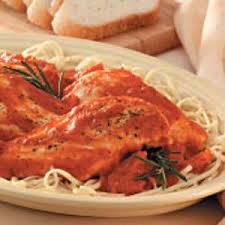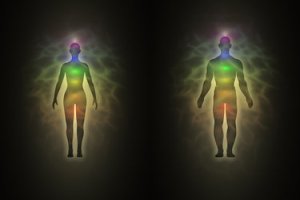American Heart Month: A Physician and Epidemiologist Shares the 20th Century History of Coronary Heart Disease
February is American Heart Month. Organizations, like the American Heart Association, hold heart-health workshops during this month, as well as events to raise funds for research into the number one killer of men and women in the United States. Coronary heart disease (CHD) was the focus of a good part of the research my husband, Roger Sherwin, a physician and epidemiologist, conducted during his 45-year career in medicine and public health. Therefore, I asked him to share with my readers the history of CHD, which increased dramatically in the earlier years of the 20th century and fell dramatically in the later years, as well as the causes of these changes.
It may surprise most Americans (including many physicians) to learn that death rates from heart disease in middle-aged American men and women were approximately equal at the end of World War I (WW I). Shortly after WW I death rates from heart disease in middle-aged U.S. males began to rise sharply, while those in women declined. With the benefit of hindsight most of the early increase in heart disease in men was attributable to cigarette smoking, a habit brought back from Europe by U.S. servicemen, and associated particularly with sudden death from CHD. Despite the popular image of the 1920’s “flapper,” cigarette smoking among American women did not become common until women replaced men in factories during World War II.
Only at the end of the decade following WW I were the terms coronary heart disease (CHD) and myocardial infarction (heart attack) coined and entered on death certificates. Interestingly, death rates from CHD in Japan did not rise despite even greater rates of cigarette smoking among Japanese men than among American men. Again, with the benefit of hindsight and a great deal of research, it became clear why Japanese men reacted to smoking differently from American men: There was a large difference in the dietary consumption of animal fat between Japan and other East-Asian countries on the one hand and Western industrialized countries on the other. This much greater consumption of animal fat in the West led to substantially higher levels of “bad” low density lipoprotein (LDL) blood cholesterol. It now appears that a long-term level of LDL above about 100 mg/dl is a necessary condition for the gradual development of life-threatening plaques in the coronary arteries (coronary artery disease), leading to coronary heart disease.
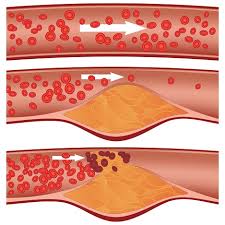 A build-up of plaque impedes blood flow
A build-up of plaque impedes blood flowAnother important change occurred after WW I. In addition to the increase in cigarette smoking, physical activity both at work and in leisure among Americans declined. Heavy manual work was now largely replaced by work assisted by self-powered machines. In leisure, the mass production of motorcars flooding American towns and countryside was also associated with reduction of physical activity—but with less difference between men and women.
![images[3] (4)](https://jsherwinblog.files.wordpress.com/2015/02/images3-4.jpg?w=479) In addition to cigarette smoking, lack of exercise, and high levels of LDL cholesterol, a number of other risk factors are known to promote CHD. These include obesity (often the result of lack of exercise), high blood pressure, and diabetes. All of these risk factors are potentially modifiable. Others, including age, gender, and family history, are important but not modifiable.
In addition to cigarette smoking, lack of exercise, and high levels of LDL cholesterol, a number of other risk factors are known to promote CHD. These include obesity (often the result of lack of exercise), high blood pressure, and diabetes. All of these risk factors are potentially modifiable. Others, including age, gender, and family history, are important but not modifiable.
Following the U.S. Surgeon General’s report on cigarette smoking and health in 1964, based largely on studies conducted in men, American men began to quit smoking, but American women continued to smoke. By the 1980s, therefore, more American women smoked than men. Accordingly, death rates from CHD in American men began to decline in 1967 and have continued to do so ever since, while death rates for American women began to decline much later and much less. Some of the decline in both sexes is, of course, attributable to public health education about the modifiable risk factors, which led in both men and women to less smoking, more exercise, heart-healthy diets, and treatment for high blood pressure with the safe and effective drugs that became available in the second half of the 20th century. Equally important were the great advances in the diagnosis and treatment of CHD, including resuscitation, rapid hospitalization, coronary care units, stents, bypass surgery, and the first really effective class of drugs to lower LDL, the statins, which can lower LDL to levels previously common only in the Far East. Statins are, of course, equally useful in the prevention as well as the treatment of CHD.
 Major signs and symptoms of coronary heart disease
Major signs and symptoms of coronary heart diseaseWhile CHD was described and diagnosed in the first half of the 20th century, only in the second half was successful prevention and treatment achieved, mainly by recognizing and modifying the causes of the disease. If cigarette smoking is largely a 20th century phenomenon, it has been replaced by an equally serious health problem—obesity. Thirty years ago about one-third of the U.S. population was overweight and half of those met the stricter definition of obesity. Today two-thirds of the U.S. adult population are overweight and half of those are obese—a 100 percent increase in both categories. Obesity is a risk factor for CHD through at least four different pathways: It leads to an increase in “bad” LDL cholesterol, a reduction in “good” high density lipoprotein (HDL) cholesterol, and an increase in blood pressure; in addition, it is the primary modifiable risk factor for diabetes. Unless the “epidemic” of obesity can be controlled, we may well see rates of CHD cease to decline or even increase as the century progresses.
My thanks to Google free images for the educational illustrations.
Amazon gift card winner and bonus heart-healthy recipe
Susi L!
Yes, my husband drew Susi’s name from the container, so an Amazon gift card is winging its way to Susi. A big THANK YOU to everyone who stopped by to leave a comment and enter the giveaway.
I also want to take this opportunity to thank all of you who have followed my blog since its inception in January of this year. I am so grateful you think I have something worthwhile to say.
As a bonus, I am sharing another heart-healthy recipe based on a dish Grandma Jennie used to make. Here it is:
Jennie’s Chicken in Tomato Sauce with Pizza Spices and Crostini
one whole boneless, skinless chicken breast
one 28 oz. can Italian crushed tomatoes
three large cloves garlic
one to three tablespoons olive oil
pecorino romano cheese for grating
black pepper
oregano
Italian bread or baguette, sliced
1. Remove skin from garlic cloves and cut cloves into thin slices.
2. In a medium to large sauce pan, sauté garlic slices in one tablespoon olive oil until slices turn golden but not brown (45 seconds to one minute). Remove pan to cool burner and remove all but one slice of garlic. Reserve other garlic slices for use later.
3. Place crushed tomatoes in a blender and mix, then liquefy, until tomatoes look creamy.
4. Pour tomato sauce into sauce pan and cook on medium or higher heat until mixture starts to bubble. Reduce heat to low. Place lid of pan at an angle to allow steam to escape. Cook for one hour, checking occasionally to make sure sauce does not boil.
5. When sauce is ready, set on cool burner.
6. Cut breast in half at connecting membrane. Remove all visible fat. On a meat-cutting board (washable), slice breast horizontally into scallopini-like slices. Place in baking dish that has a cover.
7. Ladle thin layer of sauce into bottom of dish. Place chicken slices in neat rows, covering each row with sauce, pepper and oregano. When finished pour remaining sauce over top. Season with pepper and oregano to taste. Grate cheese over top.
8. Bake, covered, at 375 to 400 (depending on your oven) for 30 to 40 minutes. Check after 30 minutes. Do not overcook.
Chicken can be served over pasta with a side salad and crostini. Remember the reserved garlic? You can spread sautéed garlic with one to two tablespoons of olive oil over slices of Italian bread or baguette. Grate some cheese over slices. Toast briefly in oven.
Note: For those who wish to avoid cheese, no problem. Both the chicken and the crostini are equally good without cheese. Use your imagination for the crostini. Slices of tomato, mushrooms, bell peppers, all make tasty toppings. And don’t forget a little oregano for added spice!
American Heart Month: The Joyful Heart Lifestyle
February 2014 marks the 50th Anniversary of Proclamation 3566, a document signed by President Lyndon Baines Johnson designating February as American Heart Month, which succeeding presidents have signed every year since. The American Heart Association, the Centers for Disease Control and Prevention, and the National Heart, Lung, and Blood Institute, active advocates for heart health, feature heart health information on their websites year round. Since the beginning of the month, the AHA has sponsored heart health workshops and held events to raise funds for continued research into the number one killer of men and women in the U.S.
Research has pointed to a number of factors that can increase or decrease the risk of coronary artery disease, which can lead to heart attacks and strokes. They include
- genes,
- the use of tobacco products,
- diet,
- high cholesterol,
- high blood pressure,
- exercise levels,
- obesity, and
- diabetes.
While we can’t change our genes, we can take charge of our heart health through the choices we make. We can choose what I call the joyful heart lifestyle.
The joyful heart lifestyle supports the bodymindspirit in its wholeness and includes a Mediterranean diet, regular exercise, medication–if prescribed by a physician, meditation for profound relaxation, and a heart-centered approach to ourselves, the people in our lives, the work we do, and the communities in which we live.
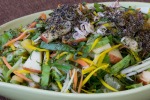 The Mediterranean diet has been in the news lately, since research has shown that it reduces the risk of heart disease. Incorporating whole grains, nuts, vegetables, fruit, olive oil, spices instead of salt, fish, and chicken, it provides a wide range of foods that can delight the senses and the spirit. Especially if you bring to food preparation the wisdom of my Italian grandmother, Jennie, for whom I was named. I would sit in her kitchen as a little girl and watch her prepare meals. One of the first lessons she taught me in her halting English was this: “the finger…puts the love into the food. Don’t be afraid to use your hands.” And my grandmother demonstrated by rubbing a bowl with love to receive the ingredients she had chopped for the salad she was preparing for dinner that night.
The Mediterranean diet has been in the news lately, since research has shown that it reduces the risk of heart disease. Incorporating whole grains, nuts, vegetables, fruit, olive oil, spices instead of salt, fish, and chicken, it provides a wide range of foods that can delight the senses and the spirit. Especially if you bring to food preparation the wisdom of my Italian grandmother, Jennie, for whom I was named. I would sit in her kitchen as a little girl and watch her prepare meals. One of the first lessons she taught me in her halting English was this: “the finger…puts the love into the food. Don’t be afraid to use your hands.” And my grandmother demonstrated by rubbing a bowl with love to receive the ingredients she had chopped for the salad she was preparing for dinner that night. 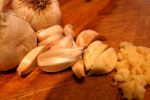
She would remove the outer covering of a garlic clove, cut the clove in half, and then, cut side down, rub the clove all over the salad bowl until every inch had been covered. My grandfather, Adamo, liked the taste of garlic, but he didn’t like to eat the clove. Every time my grandmother prepared food for him, she incorporated a little act of love. And, of course, she was serving both him and their family a salad, prepared in the Mediterranean style with olive oil and vinegar, a dressing which has been recognized to be part of a heart healthy diet.
Not everything my grandmother cooked was heart healthy, given her southern Italian heritage. Several of those dishes, including mouth-watering chicken parmesan and its eggplant counterpart, begin with breading and frying, and frying needs to be kept to a minimum or not used at all in a heart-healthy diet. The basics of healthy eating, however, were there in my grandmother’s approach to food for following generations to cull. Over the years, I’ve modified many of the dishes I learned at my grandmother’s side with, according to my husband, more than successful results. I’ll be sharing those recipes from time to time, including one at the end of this post, so check back for updates.
Incorporating regular exercise routines into our daily lives has been shown to have benefits for the cardiovascular system. You can think of it this way: since the heart is a muscle, it will benefit from staying fit. Exercise increases the heart rate and makes the heart work harder, thus increasing its capacity for work. It may also have some benefits for the aging brain. Studies have shown that exercise can increase the production of brain cells, as reported by Gretchen Reynolds in an article in the New York Times, April 18, 2012, to mention only one of numerous articles reporting this benefit. However, if you are thinking of starting a regular exercise program, the most important thing you can do to protect your heart and brain is to consult your doctor to see which kind of exercise program is right for you, especially if there is a history of heart disease or stroke in your family.
Sometimes your doctor will prescribe medication for you to control high blood pressure, one of the risk factors for heart attack, stroke, and much more. The Mayo Clinic’s website on the dangers of high blood pressure provides clear information on just what can result without treatment. I know from speaking to many physicians and from firsthand experience that taking medication daily can greatly improve the health outlook for someone with high blood pressure. Don’t be discouraged if the first medication you try doesn’t agree with you. I had to try several medications before finding one that controlled my blood pressure without intolerable side effects.
Meditation can induce profound relaxation of bodymindspirit. Meditation, as I’ve pointed out in previous posts, can be as simple as closing your eyes and breathing from the top of your head to the bottoms of your feet while visualizing light moving through your body and into the earth. These seconds-long visualizations keep you in touch with the primary flow of energy that nourishes the human energy system and moves from the spine through meridians to every cell in the body. Free flow of energy supports the natural healing and regenerative processes in the bodymindspirit and is the focus of practitioners of acupuncture and energy balancing.
Meditation with visualization is an easy introduction to stillness meditations, which can be frustrating and sometimes intimidating, and breath work with color visualization is the easiest of all. Sit in a comfortable chair with your hands resting in your lap, palms turned up. Imagine a light above your head and while inhaling see that light enter your body and move through to your feet. While exhaling, see the light pool in your feet and send roots of light deeply into the earth until your light reaches a place of great light. You may see this place as a cave of light crystals or a garden of light. Look around this place of light until you see a source of red light. Connect your light to that red light. While inhaling, see the red light move through your roots of light and into your feet. While exhaling, see the red light move into your root chakra, coming up your legs as well, into your body and out the top of your head. Inhale again, and while exhaling see the light in your aura all around you and expand your light six to eight feet. Now see yourself in a cocoon of red light. You have grounded your energies, one of the first steps in balancing your energy system, and you have supported your root chakra.
You can continue working with color, moving through each chakra in turn. See my earlier blog on color meditations.
A heart-centered approach to ourselves means knowing when to say no when demands of family or work begin to overwhelm our ability to give from the heart. Love needs to inform everything we do in life, whether it is writing to inform or persuade, relating to those with whom we think we have little in common, coping with a fussy child or an angry partner, or healing on many levels. The key is learning to love ourselves so that we can truly love others. That may mean setting boundaries to protect our energy levels when people ask too much of us. If we give more than what is comfortable for us to give, whether to family, work, or community, then love turns to resentment, and resentment harms both the giver and the receiver.
As February ends and March begins, the lessons of the joyful heart lifestyle can inform this next month and every month of the year. Adopt a heart-healthy diet and an exercise program (after consulting your physician), take medication if prescribed for you, meditate a few seconds daily and longer weekly, and approach the people in your life through your heart. Your heart will love you.
Disclaimer: All healing paths, while they share certain things in common, are unique to the individual. Nothing I write in my blogs should be construed as medical advice. All decisions about physical and mental health should be made in consultation with your physician or other licensed or certified health care practitioner.
Jennie’s Pesto Sauce
2 cups basil leaves
1/2 to 3/4 cup walnuts
1 cup olive oil
4 garlic cloves, peeled and minced
3 heaping teaspoons Grey Poupon mustard
Place above ingredients into a blender. Mix for at least 12 seconds. Then liquefy for an additional 12 seconds. Adjust ingredients to taste. This recipe eliminates animal fat, thus the absence of cheese, which is a standard ingredient in a pesto sauce. This sauce can be used on pasta, baked potatoes, chicken, and fish or used as a dipping sauce for Italian or French bread. Remember that a little goes a long way. Both walnuts and olive oil have high caloric counts per tablespoon, but are high in monounsaturated fats, which are heart healthy. Buon Appetito!

![M11083415-76[1]](https://jsherwinblog.files.wordpress.com/2014/04/m11083415-761.jpg?w=479)

